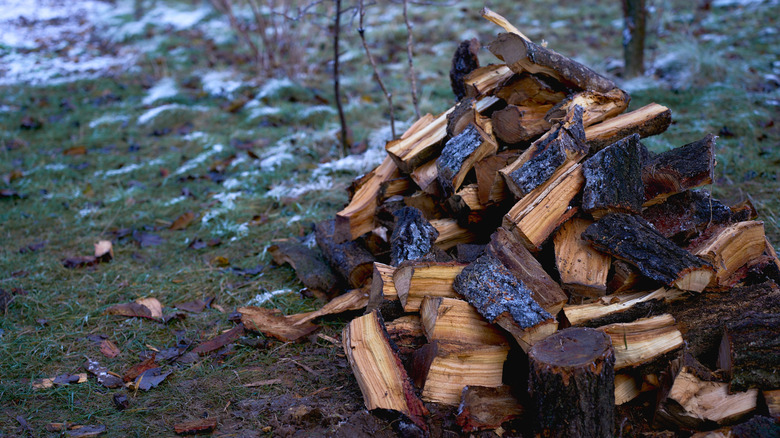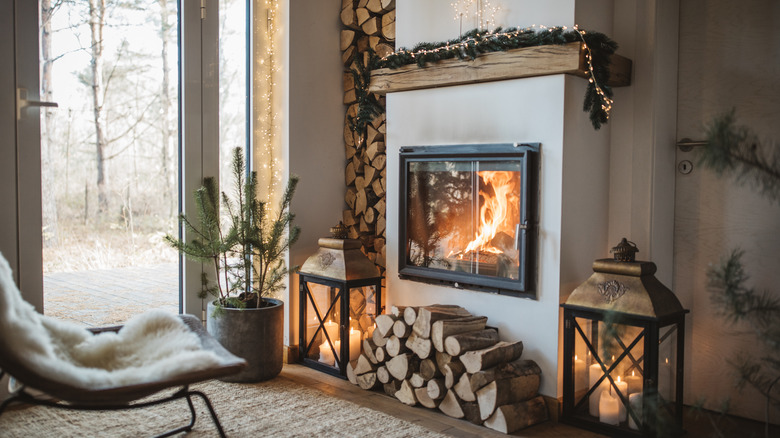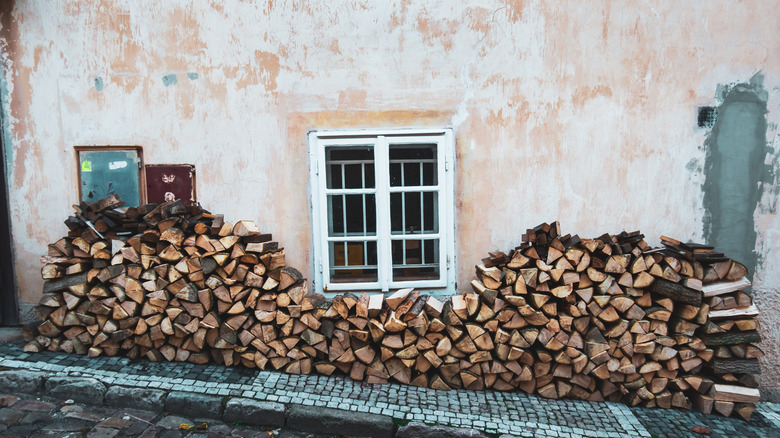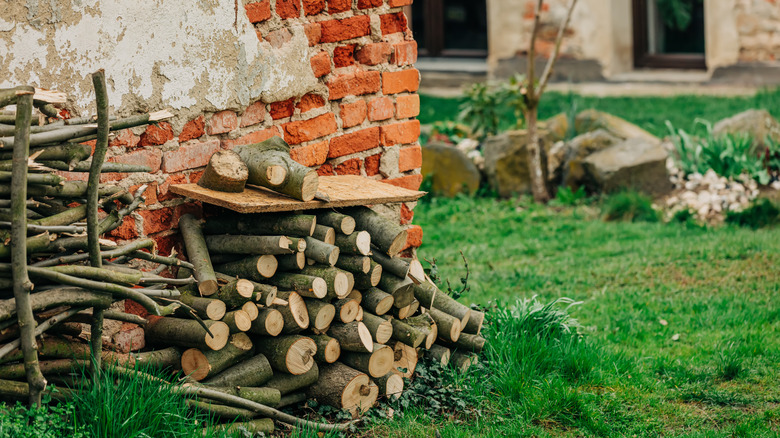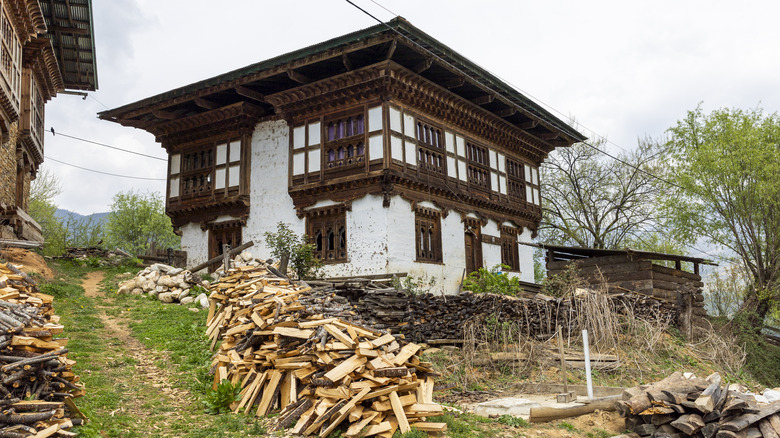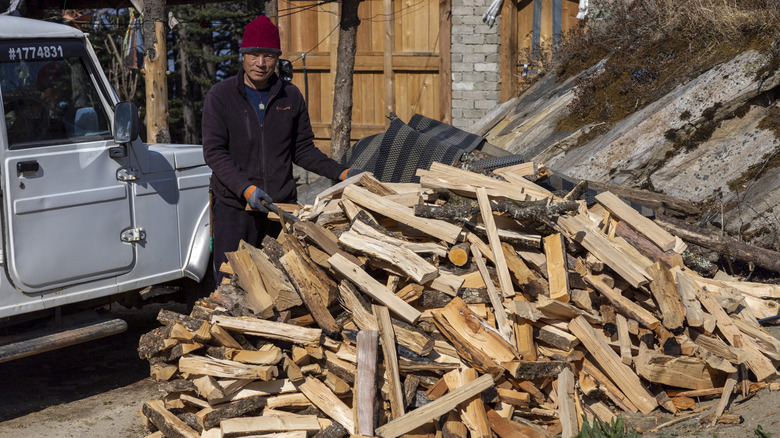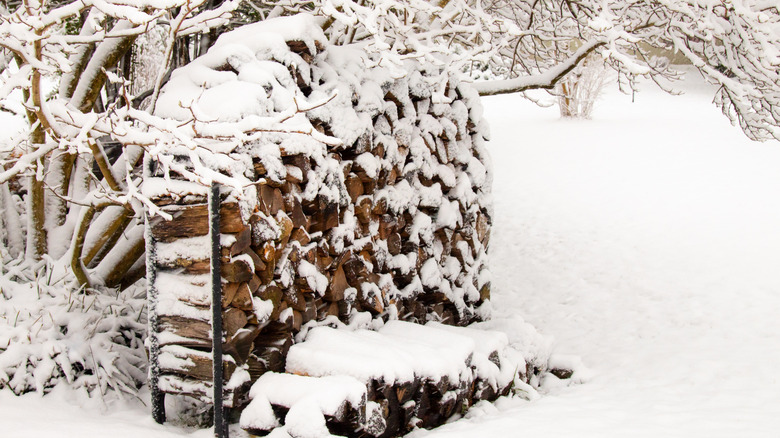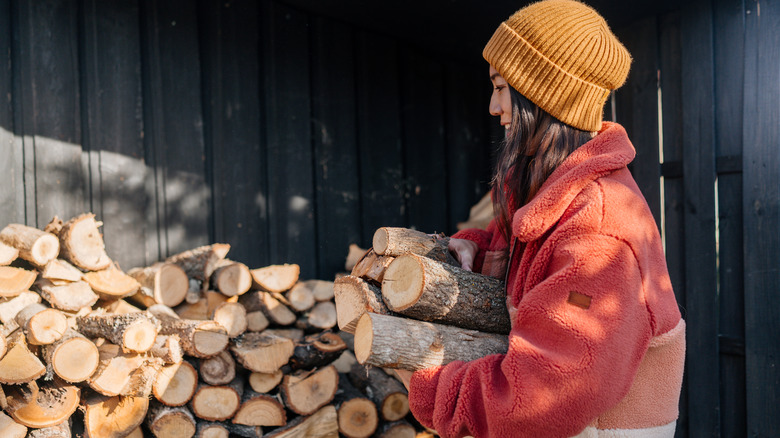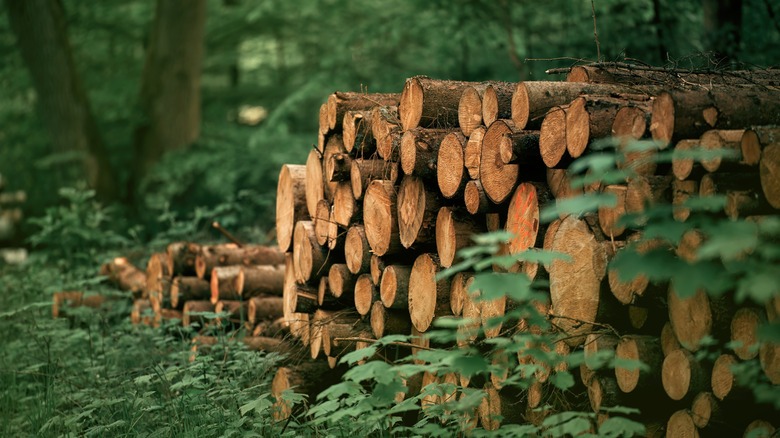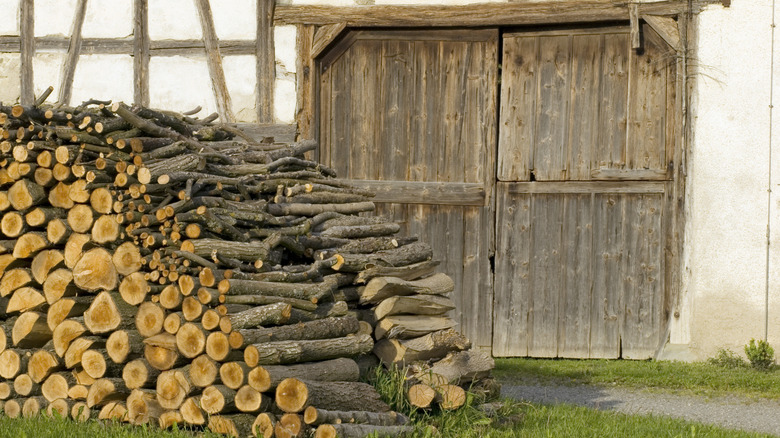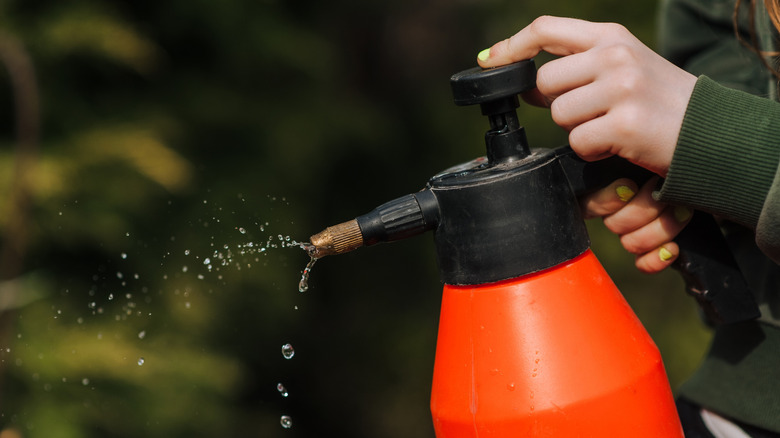Common Mistakes To Avoid When Storing Your Firewood
We may receive a commission on purchases made from links.
Whether your mind is filled with stylish stone fire pit design ideas for your summer entertaining goals or you're searching for the best wood-burning stoves to keep your home warm and cozy over the winter, you will also need to start thinking about the firewood that both of these rely on. What's more, you'll want to make a plan for storing that firewood. This might seem like such a basic task — can't you simply toss the wood in a pile outside and call it a day? Nope! This is one of the various mistakes that people make when storing firewood.
Without proper storage, you could find yourself facing a pest infestation, discovering that the wood you were planning to add to the stove or fire pit is too moist to burn efficiently, or even identifying mold growth on the logs. Clearly, none of these outcomes are what you're envisioning when you picture yourself sitting around a fire pit with friends or cozying up with a book and a warm blanket next to the fireplace. Fortunately, it doesn't have to be this way. If you learn how to avoid the most common firewood storage mistakes, you can keep your home pest-free, ensure your logs are dry and ready when you need them, and prevent other potential catastrophes from occurring.
Keeping green or seasoned firewood inside
You might be inclined to keep at least a small stash of wood for your fireplace or wood-burning stove indoors. However, you should never store freshly chopped firewood inside. In fact, it can have some very undesirable consequences. For starters, insects — such as termites, beetles, and ants — could be residing in and on the logs. If there are bugs laying dormant on the logs, they may become active once again after they've been brought into your warmer abode. This would inadvertently welcome a range of pests into your home. In addition to the pests that could be lurking in the firewood, it may also house fungi or mold, which could present health issues for those living in the home.
Instead, the best place to store firewood is outside. The mild inconvenience of going outdoors to fetch a few logs is a much better alternative than opening up your home to a pest infestation or a mold problem. If you know you're certainly going to use it, you could consider bringing wood in a day or two ahead of time. If the wood is burnt quickly, it should limit the chances of any bugs emerging. However, you should never store the logs near your wood stove or fireplace — even if it is not currently operating. Any heat source poses a risk of combustion, so choose an alternative location for the wood, such as the garage or basement.
There is one exception to the rule: kiln-dried firewood. The process for drying these logs kills any pests that may be lurking and brings the moisture content low enough to keep it inside without worry. However, you still shouldn't store kiln-dried wood in close proximity to your fireplace or stove, as the combustion risk still remains.
Piling it up right against the house
You might be inclined to keep your firewood right up against your house so you can sneak out the back door, grab a few logs, and get back in quickly. However, you should really think twice before stacking wood along the exterior of your home. If you put it next to the house, in a few short weeks or months you might find yourself searching for ways to get rid of termites. These and other pests will be attracted to the woodpile. Once they're this close to your home, it's only a matter of time before they find a way inside and cause additional problems. Leaving the wood too close to a structure is also a fire hazard. If there ever was a fire near your home, a huge stack of logs directly against it would increase the chances of the house getting caught up in the flames.
Avoid this problem by choosing a storage location that is not directly alongside your home. You should aim to keep the wood at least 30 feet away from any exterior walls. This distance should be sufficient to decrease the risk of infestation. It will also be far enough away to minimize the risk of serious damage to your property in the event of a fire.
Choosing a storage location that will keep the wood too moist
Unfortunately, simply making sure that your firewood is kept at least 30 feet away from the home isn't the only thing you'll need to consider when choosing where to store it. Instead, you'll also have to think about the specific attributes of each potential location. If the wood is put in a very shady or damp spot or one where the air is relatively stagnant, it isn't going to dry properly. Damp wood is susceptible to mold growth. Moreover, if the logs are damp when you are ready to burn them, they're not going to burn as efficiently as dry ones. This can lead you to go through more logs to keep a fire going than you would otherwise need to use. Additionally, if you're burning the logs inside in a stove or fireplace, creosote may build up. Creosote is a sticky substance that is the result of the vapor, gas, and smoke byproducts cooling as they rise through a chimney. The more creosote that accumulates inside a chimney, the greater the risk of a chimney fire.
So, what is the ideal storage location for firewood? There are a few criteria to keep in mind when assessing your yard. First, the spot you choose should receive adequate sunlight. The warm rays of the sun work to help keep the logs dry by evaporating the water they're holding. Also, make sure you don't undo the important work of the sun by choosing a location where excess water will end up dumping onto the logs, such as somewhere near a leaky gutter. Finally, the location you select should also offer plenty of air circulation. This, too, is key for helping the pieces of firewood dry out, while also decreasing the likelihood of mold growing.
Piling it up directly on the ground
With the ideal location finally selected, you may think you're in the clear and ready to unload all that firewood from your pickup truck. However, there are still more storage considerations to keep in mind to avoid making a mistake. One of these additional errors that you'll want to avoid is piling the logs directly on the ground. If the firewood is left to rest right on the ground, it will not stay dry. This can cause the logs to decay and can increase the chances of mold growing. Moreover, because many insect species are also lower to the ground, they're more likely to run across your woodpile and declare it the ideal place to take up residence.
Instead, always keep your wood reserve elevated. When kept off the ground, the lower logs won't be as likely to get damp and start rotting, and insects will not be as inclined to make themselves at home. You can keep firewood dry with a DIY storage rack, or you can stack the logs across treated wood boards. There are also outdoor storage racks specifically designed to keep the logs elevated and stacked properly, such as the Artibear Firewood Rack.
Failing to stack it properly
Believe it or not, the way you stack your firewood across the treated boards or on the storage rack you purchase may also be a mistake. Many people stack their logs very closely together. They may assume that such a configuration saves space and serves as a barrier to keep pests out and protect the innermost pieces against the elements. However, such a stacking method is actually problematic. If the logs are stacked tightly together, air won't be able to circulate around them. This means that the wood won't dry quickly. It could still be damp when you're ready to burn it, or mold may even start to grow.
There are several methods for stacking firewood that will allow for adequate airflow to keep the logs dry. These can include crisscrossing the logs to leave more openings for air, making a spiral-like pattern to promote circulation through the center of the layout, or setting up layers of vertical and horizontal logs in an alternating sequence. Regardless of the stacking method you choose, opting to store the wood pieces in such a way that ensures the cut ends are out (or the most exposed to the air around them) will be wise. This is because the ends that have been cut are the most likely to absorb excess moisture. So, when they are exposed to better airflow, everything will stay drier.
Leaving the stack uncovered
With all the talk about keeping firewood away from moisture and ensuring it is able to dry out, you probably won't be surprised to hear that leaving a stack of logs uncovered is a mistake. Leaving firewood exposed to the elements can threaten its integrity. Too much water from rain or melting snow and ice can leave the wood damp, which can decrease how efficiently it burns. As discussed earlier, damp firewood is also more susceptible to rotting, mold growth, or even an insect infestation.
So, it is essential to take measures to protect your log pile against the threats that too much moisture can cause. Covering the wood can help you achieve this goal. However, there are various considerations to keep in mind to make sure you are able to protect the logs without causing additional problems. For example, if you completely wrap the entire stack with a tight-fitted tarp, then the air won't be able to circulate properly to keep the logs dry. Similarly, the sun's rays, which also help with the drying process, won't be able to reach the wood. When using a tarp, such as the Cartman Multi-Purpose Tarp, to cover firewood, it is important to only cover the top, not the sides. Doing so blocks rain or snow from soaking the pile, but still allows proper airflow and enables the sun's rays to help keep everything dry.
Tarps aren't the only thing you can use to protect your pile from the elements. You could also consider crafting a cover with some metal roofing pieces. These won't get ripped or torn by the wind, but you'll need to find a way to secure them into place. Alternatively, you can buy a ready-made covered storage rack, such as the Lifewit Firewood Rack with Waterproof Cover.
Failing to rotate the logs in the pile
Burning your freshest wood first isn't advisable. It won't have had sufficient time to dry out properly, so it will likely still be damp. Because damp wood doesn't burn as efficiently, you'll end up going through more logs to keep the fire going. At the same time, leaving wood in your pile for too long also isn't a good idea. Over time, they may absorb too much moisture and start to rot. It is recommended to use logs within about two years.
Fortunately, there is a relatively simple solution that can help ensure you don't pull those newer logs too quickly and that you use up the older ones before they rot: Establish the practice of rotating the pile. Instead of always adding newly split logs to the top of the pile — where they're likely to be grabbed first — take time to adjust the stack so that the older pieces are on the top and the newer ones are on the bottom. Keep in mind that you'll want to allow at least six months (if not closer to 12 or even 18 months) for the wood to season properly. If your stash is running low, be sure to start cutting new logs in April to give them sufficient time to be ready for the following winter.
Keeping your stack near trees, weeds, or other plants
Location, location, location. If you didn't realize how important choosing a firewood storage spot is, you probably do now. There is one more mistake that you'll want to avoid when deciding where to put your log pile: keeping it too close to plants and trees. If you have a large tree in your yard, you might assume that the shelter it could offer from the elements will make it a great spot to store your logs. However, you could actually be risking the health of the tree if you do so. If there are any pests lurking in the wood, they can move from the logs to the tree. An infestation could damage the tree. Plus, you'd have to take quick action to clear it up before it becomes a bigger problem.
Leaving firewood too close to weeds and other plants also isn't advisable. If these are encroaching on the pile, they'll likely be adding more moisture to the logs, which can leave them too damp to burn efficiently. You may also be increasing the risk of a pest problem with your logs if any of the insects lurking in the nearby plants decide to stop by and make themselves at home.
Keep these details in mind as you decide where to store your wood. Choose a location that is not too close to any weeds, tall grasses, or other plants, and also make sure you're not storing the logs too close to a tree in the yard.
Storing unsplit logs
There are many reasons you might want to store unsplit logs. Perhaps you simply don't have time at the moment to split them all, so you're planning to do so on an as-needed basis. Or maybe you think that the larger, unsplit logs will burn better and help your fire stay lit longer. However, neither of these are actually true, and it is a mistake to store unsplit logs. Many of the issues with unsplit logs revolve around the fact that they simply don't dry as well as split ones. Because split wood pieces are smaller and have more surface area from which moisture can escape, they dry faster — often in as little as six months. The moisture in unsplit logs, on the other hand, has a much harder time evaporating as quickly. Even after a full year of drying outside, the moisture content of these logs may still be too high to burn them efficiently.
When you split the wood before storing it, it will also be easier to light on fire. This is because the whole log isn't encased with bark, which offers some fire-retardant phenolic compounds that make it flame-resistant. Because of these properties of bark, unsplit logs also tend to give off less heat while burning, and won't be as warming as if you were using split ones.
If you're not sure whether a piece of wood is dry enough to add to a fire, you can use a moisture meter, such as the General Tools Digital Moisture Meter, to identify how much moisture is left in the wood. Ideally, you want the number to be as close to 20% as possible.
Spraying the wood with pesticides to deter insects
With all this talk about pests lurking in and on your firewood, you're likely brainstorming solutions to prevent a few insects from turning into a huge infestation. And, while it's true that your log pile is a backyard feature that may be unexpectedly attracting pests into your yard, you can't simply start spraying pesticides over the stack to kill the intruders. If you spray chemicals over the wood, it could pose a potentially serious health hazard when you toss it in the fire pit or your wood stove. The chemicals that are found in pesticides can convert to toxic fumes as they burn. Inhaling these fumes could be very dangerous for you or any other family members or guests.
Part of storing and burning firewood is accepting that some insect visitors are inevitable. However, if you're careful with how you store the logs and avoid the mistakes shared above, you can limit the number of pests that show up. One additional tip is to be mindful of when you cut the logs. If you want to keep borers from being a huge problem, you could consider cutting firewood during the middle to the end of fall. These pests don't emerge until the spring, so by then your logs should be more dried out and less appealing to them.
